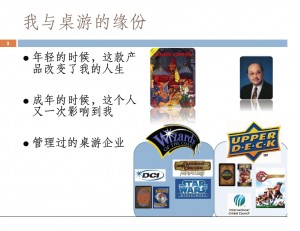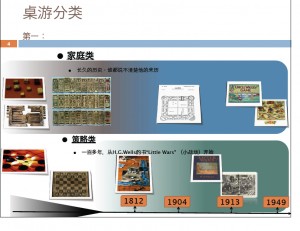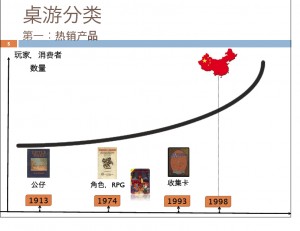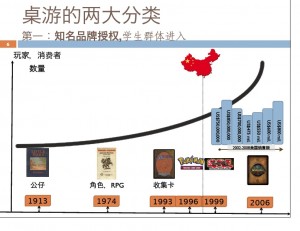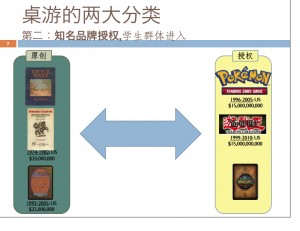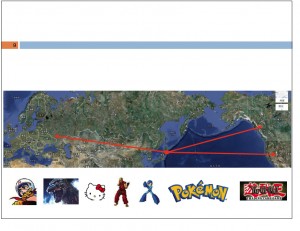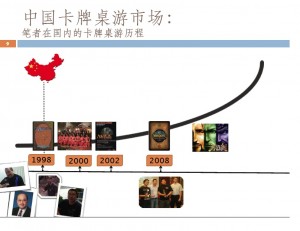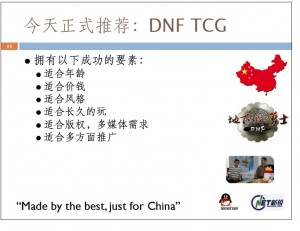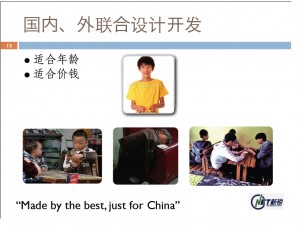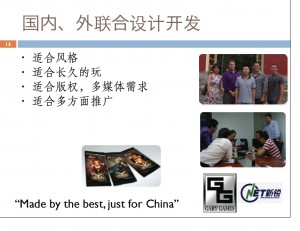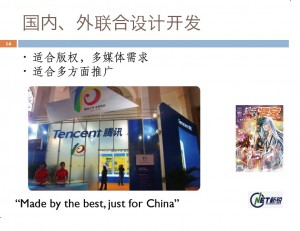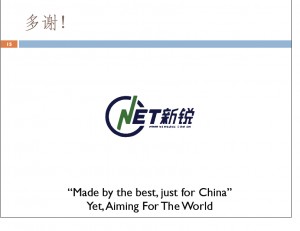China Joy Tabletop Business Forum Keynote
It was an honor to be invited and to be given a chance to explain (as a founding member of the industry here) where China’s tabletop industry had come from, and where it might be going, as well as announce our (New Edge’s) upcoming title: Dungeons & Fighters card game (DNF TCG).
Here is a recreation, in text form, of the presentation for those who couldn’t make it. Please keep in mind that I was invited to speak about the history and development of tabletop games in China. Indeed, it was an honor to be included among some of the recent stars such as Du Bin (CEO of YouKa, the makers of San Guo Sha). And unbeknowst to all of us, the folks before me could not have set the stage better. That’s because, many of them are new to the tabletop gaming scene in China and so were not aware of some of the early days. So, my primer, linking developments in China with the broader picture seemed very welcome indeed.
To get started, I thought it would be best to introduce myself.
I got my gaming start thanks to my mom and the original, 1970s Red Box D&D. I saw the stack of them in some bookstore and thought it looked very cool indeed. So nerdy, I know. After quite some begging I got it for (I think) my birthday, and tabletops were never safe thereafter. Much later, and professionally more importantly, I met Jackson Tse.
In 1994 I had made a trip home to Seattle from Kaohsiung (in Taiwan), and all my gaming friends were all hot and bothered about this new game that had swept the country: Magic: The Gathering. After I went back to Taiwan, I wrote to Mr. Tse, applying to be the distributor. Little did I know he had already granted the distributorship to a magazine company in Taipei. No matter – I just started organizing events around Kaohsiung. Then, a few years later I moved home and as part of “getting in the swing,” attended a forum put on by the China Relations Council. As fate would have it, Mr. Tse sat directly across from me. Happily the meeting went from, “Oh, yeah. I remember you,” to “You should come by the office sometime,” to “Why don’t you come by on Monday? I think I have a job for you.”
From that humble start in 1998 as the Magic Manager – China, where I began training thousands of players across the country, I went on to handle events for Asia and also Latin America. Later I was asked to take on miniatures and launched Dungeons & Dragons Miniatures and Star Wars Miniatures. After a brief hiatus in electronics, I came back to gaming and eventually joined Upper Deck, leading the China and SE Asia business, managing the World of Warcraft TCG (with partner New Edge, of course!).
Then it was time to get down to business: development of tabletop business in China. So, why not start with the world? (Please recall, this is quite new to the local audience.)
We cannot forget the long history of tabletop games, which have captivated humanity for thousands of years. For convenience’s sake, I broke them into “Family Games” and “Strategy Games.” Family games include things like dice, backgammon and cards (which were actually invented by the Chinese – thanks everyone!). As time went on, several became more codified but they were still very much “of the people,” that is to say: not commercialized. It was not until the turn of the last century that the birth of publishing games came to blossom, through folks like Milton Bradly, the Parker Brothers and others. And their main innovation was to own, brand and copyright particular sets of rules and board set ups. This ultimately attracted the likes of the Hasenfeld brothers who ultimately bought them all out. In my opinion, the same innovations from those early days more than 100 years ago remain the same. Not much new has happened there – applying new settings to the same Monopoly pretty much sums things up.
On the other hand, the “Strategy” family also traces its roots back to about the same time, to the invention of the kriegsspiel (wargame) in Germany in 1812. The innovations here were to add randomness and statistics to the various pieces, as well as setting up terrain that would affect those pieces. This makes the game more of a simulation than, say, chess. Importantly, the original kriegsspiel was an educational tool, invented by German military officers for training on tactics and strategy. However, as the German game became well recognized as a training tool, others saw its potential for entertainment. Many trace the watershed to the famous H.G. Wells small handbook, “Little Wars” in 1913 which popularized the idea of adding rules to soldiers for an afternoon’s entertainment.
And from there starts the happy history of tabletop popularity’s growth
At first, the kinds of wargames available, which is to say the sets of figures and the rules, states and terrains, were historical. Over time though, and inspired by works of fiction such as J.R.R. Tolkein’s Lord of the Rings series, fantasy and science fiction armies were introduced, thus expanding the popularity to new groups.
Eventually, this led some to wonder “what would it be like to be that particular soldier, wizards, spaceman?” Thus did Gary Gygax and Dave Arneson invent Dungeons & Dragons. A new way of looking at the table to game by providing rules, stats and terrain not for whole armies, but for individuals. Each player would now play the role of a character, defined by their stats. Instead of fighting whole battles, they would go on adventures. This innovation again expanded the audience, creating the Role Playing Game (RPG) category in 1974. (Tellingly, I got my red box in 1977.) This business and category not only learned the lessens of wider audiences, but also of greater commercialization. That is, of owning the particular intellectual property involved. That meant that they could reap the rewards of the needed investment in development and marketing. This is of course, very important and we will come back to it later.
Meanwhile, the RPG category grew steadily, inspiring many to organize regular events for fans and players to get together and play. These events became the hotbed for the next innovation: trading card games. The story is fairly famous, so let us just mention that it was Peter Adkison who discussed the need for a pocket sized game, that could be played in a short while (between “real” (RPG) gaming sessions) and which would be highly variable and flexible with Richard Garfield, who then went and invented Magic: The Gathering. The invention of the trading card game (TCG) category again expanded the audience for strategy games, happily propelling the industry forward. At the same time, games were spreading around the world, and in particular I can point to the introduction of Magic: The Gathering in China in 1997, and its full-scale launch in 1998.
So, have there been further innovations since then?
Since the invention of the current three categories, there have not been major successes in innovating new categories. But that is not to say that there is no innovation. By looking at the U.S. sales figures we can see that sales tend to have a wave form. What would explain this? One interpretation is that as new products launch it drives sales because it gives current players a chance to play something new (thus keeping them in the category, even as they chance brands) and it also brings in new players. Therefore, we can explain the first large-scale peak with the launch of the Pokemon TCG, then as sales dropped off, YuGiOh! came along and powered the sales up again. Similarly, World of Warcraft TCG has driven the wave.
This is important to understand because the sales are mostly driven by a particular brand. So, understanding how that brand has captured marketshare is key to understanding how the entire industry is operating.
To understand the driving forces, let’s divide the Strategy games into two more categories: original properties and licenses.
One may imagine that it is the original properties that drive the industry. And while that is somewhat true from a category invention viewpoint, it is less true from a revenue perspective. Indeed, Pokemon, YugiOh and World of Warcraft TCGs generated roughly 100 times the revenue of the category founders. For example, according to various press reports and company websites, games like Dungeons & Dragons generated approximately US$20 million between 1974 and 1982 (8 years). Meanwhile Magic: The Gathering reportedly generated that same amount between 1993 and 2005 (12 years). In contrast, Pokemon TCG reportedly generated US$15 billion between 1996 and 2005 (9 years) and YuGiOh TCG reportedly generated US$15 billion between 1999 and 2010 (11 years).
How can that be? Does not new game innovation drive the industry? Is that not where we should focus attention? In terms of revenue and audience numbers, new game innovation turns out to be less important than brand and marketing innovation.
What does that mean: brand and marketing innovation?
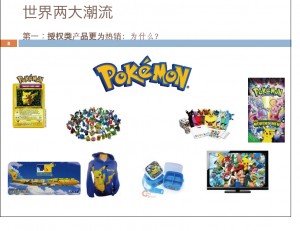 The Japanese learned well the lessons of cross-category consistency and promotion. While the Americans had invented it and Hasbro applied it to properties such as G.I. Joe in the 1980s, the Japanese recognized that more categories meant more potential audience, and therefore better sales. They therefore focused on creating consistent “universes” for their products, and rolled them out by category.
The Japanese learned well the lessons of cross-category consistency and promotion. While the Americans had invented it and Hasbro applied it to properties such as G.I. Joe in the 1980s, the Japanese recognized that more categories meant more potential audience, and therefore better sales. They therefore focused on creating consistent “universes” for their products, and rolled them out by category.
As a result, all the categories get a lift because a comparatively huge audience now has a wealth of choice for where to spend their money. Tabletop games, especially TCGs become one of the lynchpin categories in this expansion because they became a kind of currency among the fans. Everyone recognized the value of the characters, so they wanted to have that incarnation. Many also wanted to play the game, but that is not truly necessary to generate sales. And because the TCG found itself among a huge family of other products, each mutually supporting the brand overall, sales rolled in.
The important thing to note here, as industry professionals, is: without ownership of the property none of this is possible. If someone can easily borrow your “universe,” you immediately have a fractured audience. Likewise, many fewer partners should be willing to take your license because they cannot accurately predict how their investment will be rewarded.
One more note before moving on.
As we look around the world at this business strategy, its important to realize that there are Asian examples, Japan being the leading one. Only by seeing what they have done successfully can we (here in China) set our sites further ahead.
So, in addition to understanding the brand lessons just mentioned, it is also important to note their confidence in their own cultural expressions. In all the major international brands, how many are about samurai? Ninja? Tea ceremonies? And so on? These are certainly rich cultural wells to draw from, yet the number and success of properties like Godzilla, Hello Kitty, Street Fighter and many others is obviously Japanese…yet does not draw directly from that well.
Why? Put simply: no one can own those original, deep cultural items. How can they then be commercialized? And if they cannot be commercialized, how will any new cultural items (whether TV, movie, game, etc.) be made? A firm will not want to invest in something that is not going to reap a reward, is it?
So, coming back to China, let’s see where we are.
Funny story about me joining Wizards of the Coast. When I joined, the company had a regular “breakfast with the CEO” where Peter Adkison would meet all the new employees. As we went around the table, introducing ourselves, Mr. Adkison would nod and say “hi.” Then it got to be my turn. When I had finished, Mr. Adkison sat back in his chair and said thoughtfully: “Ohhh. You’re that guy.” I wasn’t sure what that might mean, but I sure hoped “that guy” was a good thing!
Be that as it may, back in 1997 Mr. Tse founded some relationships with the TiYu University and the State Sports for All council. There were approximately 20 people who knew how to play Magic in China when I arrived on the scene in 1998. Throughout 1998 and 1999, I organized training and events around the country teaching thousands of players, and organizing hundreds of clubs. Of course, I did not do this all alone. Importantly, I hired a small team, including Cheng Li Xue (Michael) (who is now the distributor of Magic through his RuiKa company) and I worked with Li Xiang (Terry), who joined the distributor side. And so, over the years I was proud to organize the first National Championship, the first big prize tournaments and eventually to see Grand Prix and other Magic events hosted in China.
Later, in 2007 I was approached by Upper Deck’s Vice President of Asia who was looking for a distributor of World of Warcraft TCG for China. I was happy to introduce Terry and promote him as the best choice. Eventually Terry won the distributorship and you all know him today as the owner of New Edge.
And on this foundation and growing appreciation of TCGs, we must say thanks to the makers of SanGuoSha. This was China’s breakthrough product, to be sure. Teaching as I have been at the Hong Kong Polytechnic University, I can say that in 2005 students coming from the Mainland had not really heard of TCGs. Then, suddenly, in the past couple years the response became: “Oh, you mean like SanGuoSha?” Very telling indeed.
Still, when we look at China, what do we see?
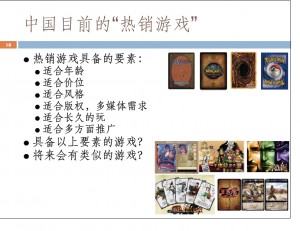 The first thing we see is a few foreign brands, some more successfully pirated than others. Then we see…Three Kingdoms! Why, oh why are there so many Three Kingdom’s games?!
The first thing we see is a few foreign brands, some more successfully pirated than others. Then we see…Three Kingdoms! Why, oh why are there so many Three Kingdom’s games?!
As you can imagine from what I said above, I think this is a huge mistake. As soon as one game becomes popular, there will be a million others using the same characters, thus fracturing your potential audience. As industry professionals, we should see the inherent weakness of this strategy. So, what would be stronger?
As New Edge looks at the situation, we believe the important elements for the next breakthrough product include: the right age group, the right price, the right partners, the right property (with multi-media categories), the right design (for long-term play and entertainment), suitable for cross category promotion and marketing.
We ask ourselves: does such a game exist out there today? Will such a game be made?
Its our pleasure to announce: the Dungeons and Fighters TCG
We feel it suits all the important characteristics of a successful game. It will have a new and very suitable target age. It will be very competitively priced. We have excellent partners. We are confident our design will provide long-term playability. It is ideal for cross-category promotion and has multi-media embedded in the property’s heart.
Our target age and group…
Where Magic and World of Warcraft TCG target older teens and young twenty-somethings, we will target younger teens.
They will have seen cards, and liked them. They love to play with them, enjoying card games over other sorts of entertainment. And they like to play them with their friends.
And we are sure they will be interested in our price: RMB5 for a five-card booster pack.
Our partners…
I am happy, proud and privileged to have formed a partnership with Justin Gary, a U.S. national champion in Magic: The Gathering, and maker of the very popular Ascension game. Likewise, it is an honor to be working with his Vice President of “Keeping it Real,” John Fiorillo. Together, Justin, John, Terry and I are leading the design team to create an excellent game for the youth of China.
Likewise…
We are proud to have a license from TenCent, Dungeon’s and Fighters, one of the most popular online games in China. We will not only satisfy the need for multimedia, but also through scratch cards and codes that reward players with online game merchandise.
So, in closing…
Let me just say “Thanks” and see you this fall!
